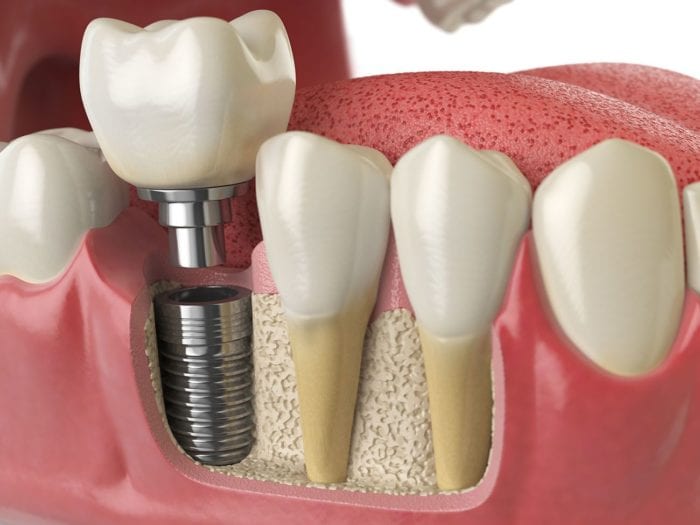The 8-Minute Rule for Dental Implants
All about Dental Implants
Table of ContentsDental Implants for DummiesDental Implants Things To Know Before You BuyDental Implants Can Be Fun For AnyoneSee This Report on Dental Implants
are medical gadgets surgically dental implanted into the jaw to recover an individual's ability to chew or their look. They supply support for fabricated (fake) teeth, such as crowns, bridges, or dentures. When a tooth is shed because of injury or condition, a person can experience complications such as fast bone loss, defective speech, or modifications to chewing patterns that cause discomfort.
Framework of The Oral Implant System picking dental implants, speak with your dental copyright concerning the possible benefits and dangers, and whether you are a candidate for the treatment. Things to consider: Your total health and wellness is a crucial consider figuring out whether you are a great candidate for dental implants, how much time it will certainly require to recover, and just how long the dental implant may remain in location.
Smoking cigarettes might affect the recovery process and decrease the long-term success of the dental implant. The healing procedure for the implant body might take a number of months or longer, during which time you normally have a short-lived abutment in area of the tooth. the dental implant treatment: Very carefully comply with the dental hygiene directions provided to you by your oral service provider.
The Single Strategy To Use For Dental Implants
Implant failure can result in the need for another operation to fix or replace the dental implant system. Recovers the capacity to eat Restores cosmetic look Aids keep the jawbone from diminishing because of bone loss Protects the health of the surrounding bone and gums Assists maintain nearby (neighboring) teeth steady Boosts lifestyle Damage to bordering natural teeth throughout implant placement Injury to the surrounding tissues throughout surgical treatment, such as sinus perforation Injury throughout surgical procedure (as an example, fracture of surrounding jawbone) Poor feature, such as seeming like the teeth do not attack together typically A feeling that the tooth hangs or turning in area arising from a joint screw loosening up Implant body failing (looseness of the dental implant body) due to systemic infection, which may be more probable in people with unchecked diabetes because of neighborhood infection in bone and periodontals sustaining the dental implant body due to delayed recovery, which might be extra most likely in clients that smoke Difficulty cleansing the gum tissues around the implant, leading to inadequate oral health Without treatment gum condition Post-surgical feeling numb as a result of nerve impingement or damage Always alert healthcare suppliers and imaging service technicians that you have dental implants prior to any kind find more information of magnetic vibration imaging (MRI) or x-ray procedures.
FDA is not knowledgeable about any type of damaging events reported for MRI or x-ray procedures with oral implants. Dental implants systems are typically made of products that adhere to global agreement criteria of the International Organization for Standardization (ISO) or ASTM International. These standards have information of what makes a risk-free material.
Other products such as gold alloys, cobalt-based alloys, titanium alloys, or ceramic materials are occasionally used. The safety and security profiles of these materials are widely known. Oral implant systems are examined according to global consensus requirements. Biocompatibility screening, to show that bodily call with the tool does not create problems like inflammation or sensitive reaction, belongs to the examination that assists make certain the materials in the dental implant system are safe and do not trigger damaging results when dental implanted in individuals.

Not known Details About Dental Implants
Some individuals are not eligible for dental implant surgery. It is for dental doctors to operate on people with: severe illnessuncontrollable metabolic diseasebone or soft tissue condition or infectionIf these concerns are fixed, an individual can have the surgical treatment. Dental Implants. In, oral cosmetic surgeons avoid operating individuals with: If people with any one of the above read review undergo dental implant surgical procedure, there is a greater danger of the dental implant falling short
Some people have a jawbone problem that protects against adequate bone for a dental implant from creating. In such instances, a surgeon may need to do a ridge adjustment. This includes lifting the periodontal to expose the area of warped bone. The doctor will certainly after that utilize a bone or bone alternative to repair and develop up the location.
Oral dental implant surgical treatment is a tailored procedure. It's not the exact same for everybody. But the following offers a basic overview of what you can anticipate your dentist, oral cosmetic surgeon, periodontist or prosthodontist to do: Position the implant operatively. Provide you time to heal. Affix the article and final crown, bridge or denture.
Next, your doctor will very carefully place the oral implant right into your jaw. If your implant is near the front of your mouth, your dental practitioner sites will make a short-lived tooth for you to wear up until you recover.
More About Dental Implants
Your company can inform you what to anticipate in your circumstance. During the recovery stage, your jawbone should fuse to the oral implant. This process, called osseointegration, is critical for stability and lasting success. This procedure can take anywhere from three to nine months. Sometimes, it may take longer.
Once your implant heals, your dentist can affix the joint (tiny adapter blog post) and your last restoration (crown, bridge or denture). This typically takes about one hour to finish and may require a 2nd minor surgical treatment. You should not really feel any type of pain throughout your oral implant procedure because your service provider will certainly utilize medication to numb your gum tissues.